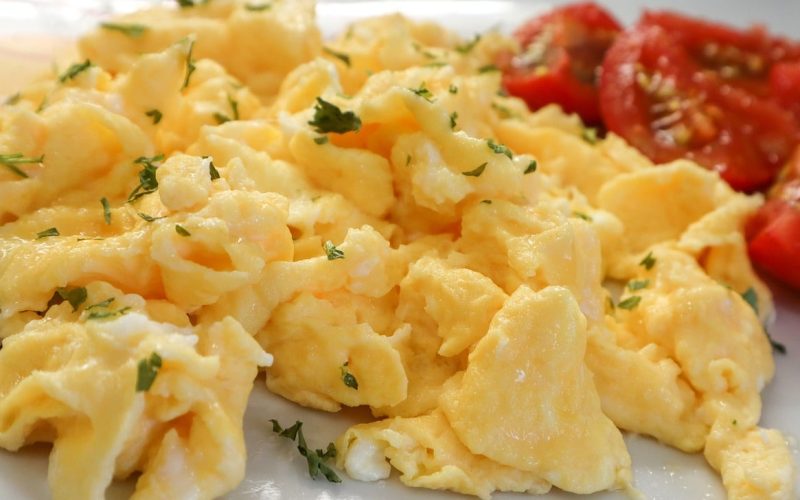We’re starting on a journey to understand how many calories are in the foods we eat, and today’s focus is on a breakfast favorite: scrambled eggs.
But before we dive into the specifics of how many calories in two scrambled eggs, let’s take a moment to understand the concept of counting calories.
What is Calorie Counting?
Calorie counting is a way of keeping track of the energy you’re taking in and using throughout the day.
Every food and drink item contains a certain amount of calories; these are the units of energy that your body needs to function.
By counting calories, you’re monitoring the energy you’re putting into your body.
If you’re new to calorie counting and would like a more detailed explanation, feel free to visit our article on what is calorie counting.
Why Count Calories?
Why would you want to count calories? Well, there are several reasons.
First, it can help you maintain a healthy weight, as you’ll know exactly how much energy you’re consuming and can balance it with the energy you’re using up through physical activity.
Second, it can assist in planning meals and snacks that align with your health goals.
Lastly, understanding the calorie content of different foods can help you make healthier choices as you become more aware of which foods provide a lot of energy (i.e., calories) but very little nutritional value.
With our understanding of calorie counting, we’re now ready to dive into the specifics of how many calories are in two scrambled eggs. Let’s get cracking!
Understanding Calories in Eggs
Before we delve into figuring out how many calories in two scrambled eggs, let’s first understand the nutritional value of eggs and the calorie content of a single egg.
Nutritional Value of Eggs
Eggs are a powerhouse of nutrition. They’re packed with high-quality protein, healthy fats, vitamins, and minerals.
Here’s a quick overview of the nutrients found in a single, large egg:
| Nutrient | Amount |
|---|---|
| Protein | 6.3 g |
| Total Fat | 4.8 g |
| Saturated Fat | 1.6 g |
| Cholesterol | 186 mg |
| Vitamin A | 270 IU |
| Vitamin D | 41 IU |
| Calcium | 28 mg |
| Iron | 0.9 mg |
Eggs also contain small amounts of Vitamin B6, Vitamin B12, Vitamin E, Magnesium, Potassium, and Zinc.
How Many Calories Are in an Egg?
The calorie content in an egg can vary slightly depending on its size. However, a large egg typically contains around 70-80 calories.
Here’s a simple breakdown:
| Egg Size | Calories |
|---|---|
| Small (38 g) | 54 |
| Medium (44 g) | 63 |
| Large (50 g) | 72 |
| Extra Large (56 g) | 80 |
| Jumbo (63 g) | 90 |
As you can see, the size of the egg plays a significant role in determining its calorie content.
This will be important to keep in mind when calculating how many calories in two scrambled eggs.
The Art of Scrambling Eggs
Scrambling eggs might seem like a simple task, but there’s an art to it.
The way you prepare and cook your eggs can have a significant impact on the overall calorie content.
Let’s explore this further.
Basic Recipe for Scrambled Eggs
A basic scrambled egg recipe involves the following steps:
- Crack two eggs into a bowl.
- Whisk the eggs until the yolks and whites are fully combined.
- Heat a non-stick pan over medium heat.
- Add a small pat of butter to the pan and let it melt.
- Pour the beaten eggs into the pan.
- Stir the eggs gently with a spatula until they’re lightly set but still slightly runny.
- Remove the pan from the heat and let the residual heat finish cooking the eggs.
This simple recipe can be the basis for a low-calorie, protein-rich meal.
However, the calorie count can increase depending on what you add to your scrambled eggs.
How Cooking Affects Calorie Count?
The way you cook your eggs can affect their calorie content. For instance, using butter to cook your eggs will add more calories.
A tablespoon of butter adds around 100 calories. If you’re watching your calorie intake, you can opt to cook your eggs in a non-stick pan without any added fat.
| Ingredient | Calories |
|---|---|
| 2 Eggs | 140 |
| 1 Tbsp Butter | 100 |
| Total | 240 |
On the other hand, adding ingredients like cheese or bacon will also increase the calorie count.
For example, a slice of cheddar cheese adds around 113 calories, while a slice of cooked bacon adds approximately 42 calories.
| Ingredient | Calories |
|---|---|
| 2 Eggs | 140 |
| 1 Tbsp Butter | 100 |
| 1 Slice of Cheddar Cheese | 113 |
| 1 Slice of Cooked Bacon | 42 |
| Total | 395 |
The key to understanding how many calories in two scrambled eggs lies in the additional ingredients you use and the method of cooking.
For more insights into the calorie content of various foods, check out our articles on how many calories in rice or how many calories in fries.
Determining the Calories in Two Scrambled Eggs
You’ve probably asked yourself, “How many calories in two scrambled eggs?” Well, let’s break it down for you.
Breaking Down the Calorie Count
The caloric content of two scrambled eggs depends on a few factors. The first is the size of the eggs.
The USDA lists a large egg as having about 72 calories. So, two large scrambled eggs would contain roughly 144 calories.
However, it’s important to note that most scrambled egg recipes include milk and butter for a creamier texture.
Let’s say you add a tablespoon of whole milk (roughly 9 calories) and a teaspoon of butter (about 34 calories); the total calorie count would then be approximately 187 calories.
Here’s a simple table to illustrate this:
| Ingredient | Calories |
|---|---|
| Two large eggs | 144 |
| Milk (1 tbsp) | 9 |
| Butter (1 tsp) | 34 |
| Total | 187 |
Factors Influencing the Total Calories
Several factors can influence the total calorie count of your scrambled eggs:
- Add-ins: Things like cheese, bacon, or veggies can significantly alter the calorie count. For example, a single slice of cheddar cheese could add an additional 113 calories.
- Cooking oil or butter: The type and quantity of fat you use to scramble your eggs can also add a significant number of calories. For example, a tablespoon of olive oil adds around 119 calories.
- Serving size: The number of eggs you consume will directly influence the calorie count. If you opt for three eggs instead of two, you’ll be consuming more calories.
Remember, while it’s helpful to know the calorie content of your food, it’s just as important to consider its nutritional value.
Eggs are a rich source of protein and several essential nutrients.
So, while they may have a certain number of calories, they’re also contributing to your overall nutritional health.
For a deeper dive into calorie counting and why it’s important, check out our article on what is calorie counting.
Tips for Making Lower-Calorie Scrambled Eggs
Just because you’re counting calories doesn’t mean you have to sacrifice flavor or satisfaction in your meals.
There are plenty of ways to whip up delicious, lower-calorie scrambled eggs without feeling deprived.
Let’s explore some of them.
Choosing Healthier Add-Ins
The add-ins you choose can significantly affect the calorie count in your scrambled eggs.
Adding vegetables like spinach, bell peppers, and onions enhances the flavor and increases the nutrient content without adding many calories.
They are low in calories and high in vitamins and minerals.
If you love cheese in your scrambled eggs, consider using a smaller amount of stronger-flavored cheese like feta or sharp cheddar.
This way, you’ll still get that cheesy flavor you love without too many additional calories.
You can find more information about the calorie content of different cheeses in our article on how many calories in feta cheese.
| Add-In | Calories (per 50g) |
|---|---|
| Spinach | 11 |
| Bell Peppers | 15 |
| Onions | 20 |
| Feta Cheese | 70 |
| Cheddar Cheese | 200 |
Adjusting Cooking Techniques
The way you cook your scrambled eggs can also make a difference in their calorie content.
Using cooking spray instead of butter or oil can significantly reduce the number of calories without sacrificing the non-stick benefit.
If you usually add milk or cream to your eggs to make them fluffy, try using a lower-calorie alternative like almond milk or even water. You’ll still get fluffy eggs but with fewer calories.
Remember, the key to enjoying lower-calorie scrambled eggs is to focus on adding flavor without adding unnecessary calories.
You can enjoy delicious scrambled eggs that align with your calorie goals by choosing healthier add-ins and adjusting your cooking techniques.
For more calorie counting tips, check out our article on what is calorie counting.








